Resource Adequacy in ERCOT: How Long-term Market Design Reforms Could Enhance Reliability

Table of Contents
Author(s)
Kenneth B. Medlock III
James A. Baker, III, and Susan G. Baker Fellow in Energy and Resource Economics | Senior Director, Center for Energy StudiesShih Yu (Elsie) Hung
Research Manager, Center for Energy StudiesShare this Publication
- Print This Publication
- Cite This Publication Copy Citation
Kenneth B. Medlock, "Resource Adequacy in ERCOT: How Long-term Market Design Reforms Could Enhance Reliability" (Houston: Rice University’s Baker Institute for Public Policy, December 12, 2022), https://doi.org/10.25613/8PEA-N556.
Foreword
The events in Texas surrounding Winter Storm Uri in February 2021 triggered a significant re-evaluation of the Electric Reliability Council of Texas (ERCOT) market. This sits squarely within the realm of concerns related to reliability in electric power markets, especially as generation shifts toward a greater proportion of intermittent resources (i.e., wind and solar). Indeed, Senate Bill 3 (2021) requires the Public Utility Commission of Texas (PUCT) to reform ERCOT market design to enhance reliability.
In December 2021, the PUCT released its “Approval of Blueprint for Wholesale Electric Market Design and Directives to ERCOT.” The blueprint is distinct from other steps taken to ensure reliability (such as weatherization and protocols for better communications) and consists of two phases. Phase I implementation began in January 2022, and was focused on providing “enhancements to wholesale market mechanisms” to improve reliability. A primary goal of electricity market design is to leverage the efficiencies of markets and the price signals they send to ensure adequate operational capacity with sufficient system-wide flexibility. The ultimate goal is to ensure reliable service at all times.
On July 12, 2022, the Center for Energy Studies at Rice University’s Baker Institute for Public Policy hosted a workshop to explore the question of resource adequacy being addressed in the long-term market design reforms under consideration in Phase II of the PUCT’s blueprint. The workshop was held under Chatham House rule. Participants included ERCOT market participants and representatives from the energy industry, academia and NGOs.
Key highlights from the discussion included:
- Strong population growth has contributed to steadily growing electric power demand in Texas, which contrasts with other states where population and electricity demand are either stagnant or declining.
- The electric power market is diversifying rapidly with new entrants on both the demand and supply sides, which carries challenges but could also create novel interactions with the grid in the future. Some examples of new entrants include wind and solar generation resources, batteries, cryptocurrency miners and electric vehicles.
- Combined-cycle natural gas generation development in ERCOT has not grown in recent years. Low wholesale electricity prices have negatively impacted assessments of the profitability of new capacity. Meanwhile, the fleet of single-cycle gas turbines has diminished as units have been retired rather than upgraded for emissions compliance.
- Price discovery is a vital enabler of supply-demand balancing, and generator performance must be warranted for stable market function. A main takeaway was that the Texas market needs effective price discovery with penalties for non-performance or obligations to procure if generators underperform.
- Backstop reliability service is analogous to holding an insurance policy with a distinct risk premium. Thus, the risk profile of the generation must be adequately assessed in order to price reliability services appropriately. If reliability is compromised over time, higher risk assessments — and hence higher prices — will be required to justify any long-term investment.
- System reliability is critical to a functional market.
Background and Presentations — Context for Discussion
Winter Storm Uri in February 2021 exposed weaknesses in the Texas energy system.[1] Some of the problems were avoidable, but all of them triggered a massive wave of deliberation about possible reforms, leading the PUCT to file wholesale market design reforms. The PUCT has split its reforms into two phases.[2]
Phase I, which began in January 2022, includes various market design elements. Notably, the operating reserves demand curve (ORDC) cap was reduced from $9,000 to $5,000 per megawatt hour (MWh), and the minimum contingency level (the minimum reserves deemed necessary to avoid system-wide failure) was increased to 3,000 megawatts (MWs).[3] The newly created “firm fuel supply service” targeting gas generators and on-site dual fuel resources is intended to enforce “firm fuel” availability for 48 hours for increased reliability, with possible expansion to offsite gas storage. Another initiative is to increase administrative procurement of ancillary services — including emergency response, fast frequency response, contingency reserves, non-spinning reserves and voltage support — and create a de-facto capacity market through the existing day-ahead market.
Phase II, currently in progress, focuses on ensuring ERCOT has sufficient operating capacity during extreme events resulting from weather, high demand and/or low renewables output. This phase also introduced a “load-side reliability mechanism” with multiple proposals being developed/evaluated. These include:
- a backstop reliability service (BRS) that enforces payment to generators to reserve their resources for extreme conditions. A reserve of 6 to 7 GWs in BRS would be necessary to stimulate energy prices, spur new investments and discourage retirements.
- a dispatchable energy credits (DECs) program that requires customers to procure a certain number of DECs sold by new generators, with ERCOT serving as a central clearinghouse. DECs pay new dispatchable generation sources to be available on a firm basis to customers. But some participants noted that such a program could marginalize older generation resources that do not receive such payments, thereby making them less competitive and driving retirement of DECs (i.e., the “bump out” effect).
- a load serving entity obligation (LSEO) that requires load serving entities (LSEs) to maintain sufficient resources to produce electricity, or interruptible demand to curtail load during critical events, effectively “counting every MW” of tail events. This obligation would be subject to penalties for non-performance.
- centralized capacity auctions that designate capacity payments to incentivize investment in capacity.
It is important to note that some of the measures from Phase II are mutually exclusive.
The conversations about the PUCT’s actions were embedded in discussions of electricity demand growth and the evolution of the generation portfolio over the past couple of decades. Electricity demand has seen strong growth in Texas over the last three decades. This owes to healthy economic and population growth. In fact, as can be seen in Figure 1, population and electric power sales are strongly correlated, with a simple correlation of 0.982.[4]
Figure 1 — Texas Population and Electric Power Sales
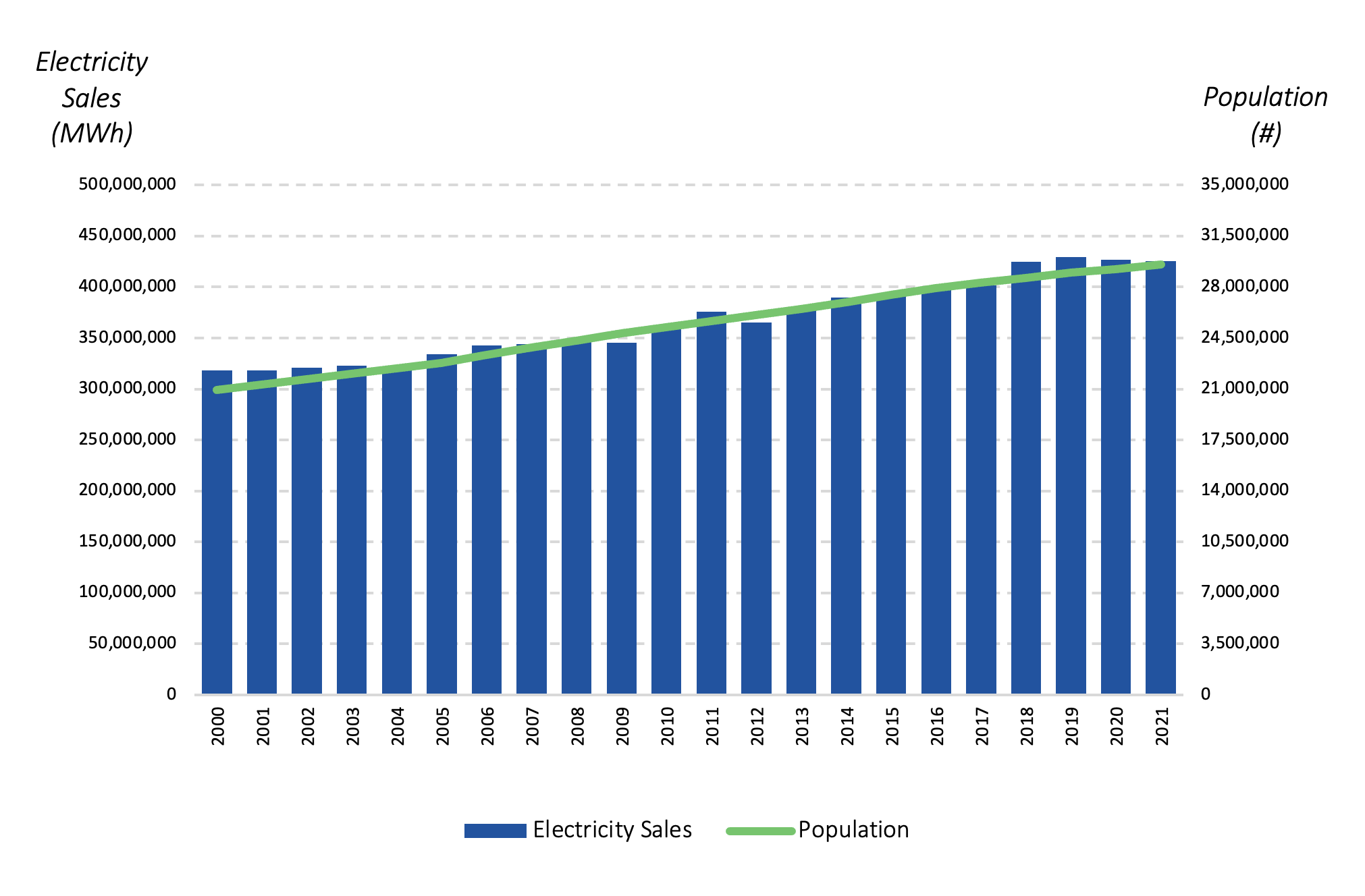
Future demand was central to the discussion, and multiple drivers were mentioned. For example, it was noted that electric heating is considered an important influence, with Texas ranking first in the nation in the total number of housing units using electric heating (5.99 million). As the population in Texas continues to expand, this represents a source of electric power demand growth as well as a reinforcement of the tight linkages between electricity and natural gas markets in the state.
As another example, it was noted that the anticipated growth in the electric vehicle (EV) fleet and the necessary charging infrastructure to support expansion portends significant increases in future power consumption. Level I adapters for recharging have the capacity for only 4 miles per hour of charging, while the much larger Level II adapters provide anywhere from 5 to upward of 60 miles of range every hour, depending on the current supported by the charger. The EV industry and its vendors are actively exploring the use of vehicles for demand-side response. Bidirectional chargers that enable charged EVs to pump power back to grids are in the market, but they are very expensive and not yet widely deployed. As recharging infrastructure expands, it will bring with it increased demand but also potential load management opportunities, depending on consumer behavior.
Figure 2 — ERCOT Capacity Additions (Historical and Planned) for (a) Wind, (b) Solar, (c) Gas Combined-Cycle (CCGT), (d) Gas Turbines (GT) as of June 30, 2022
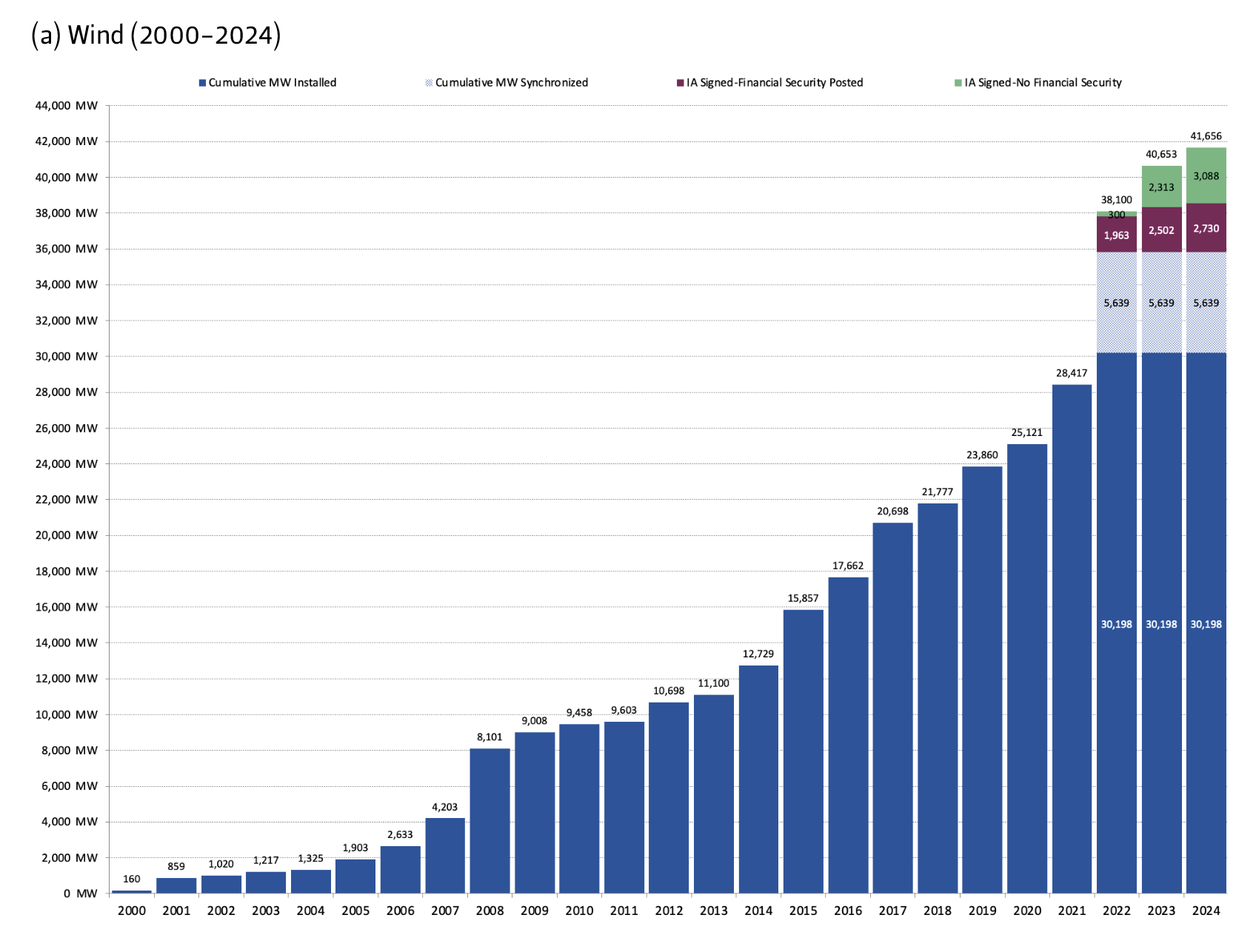
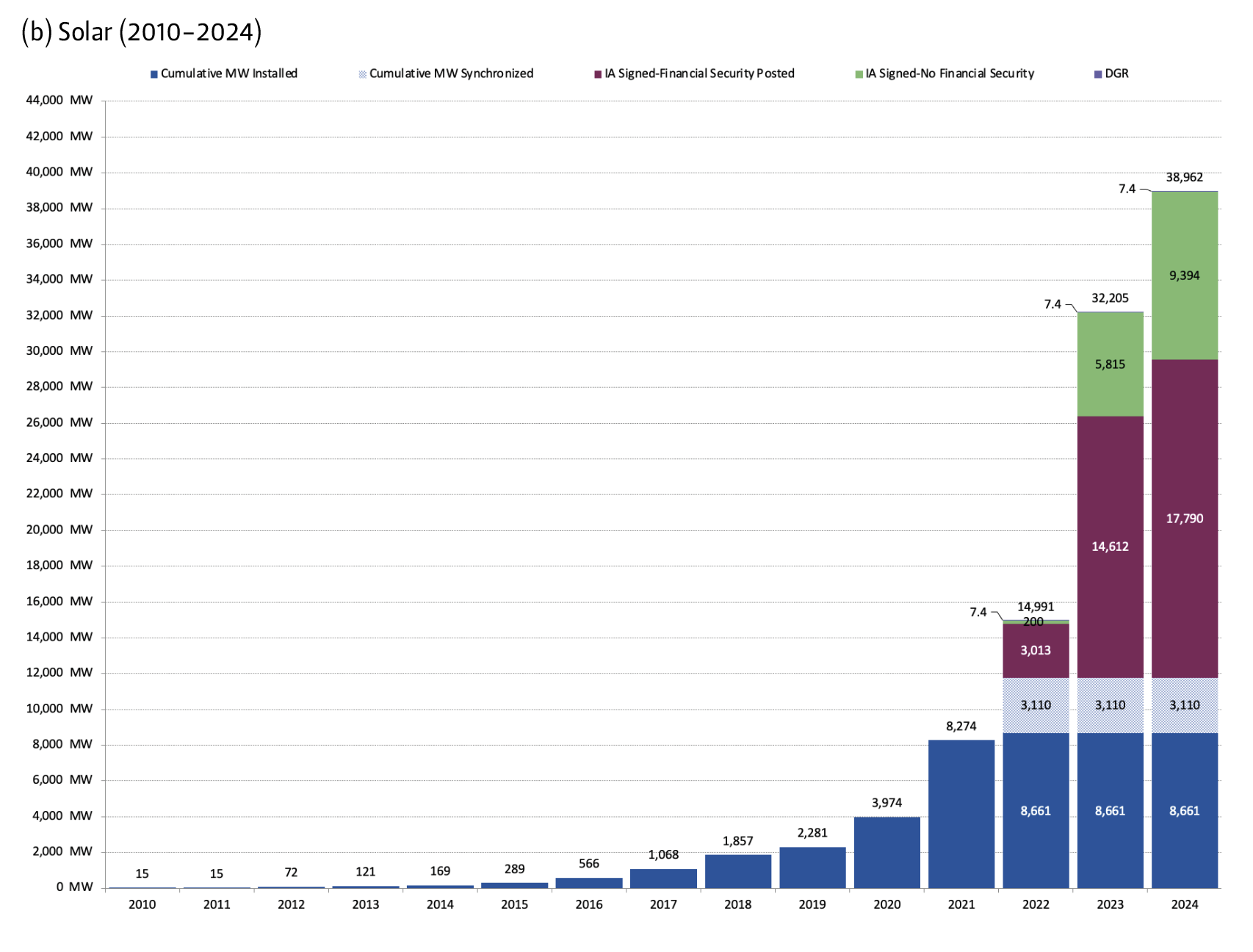
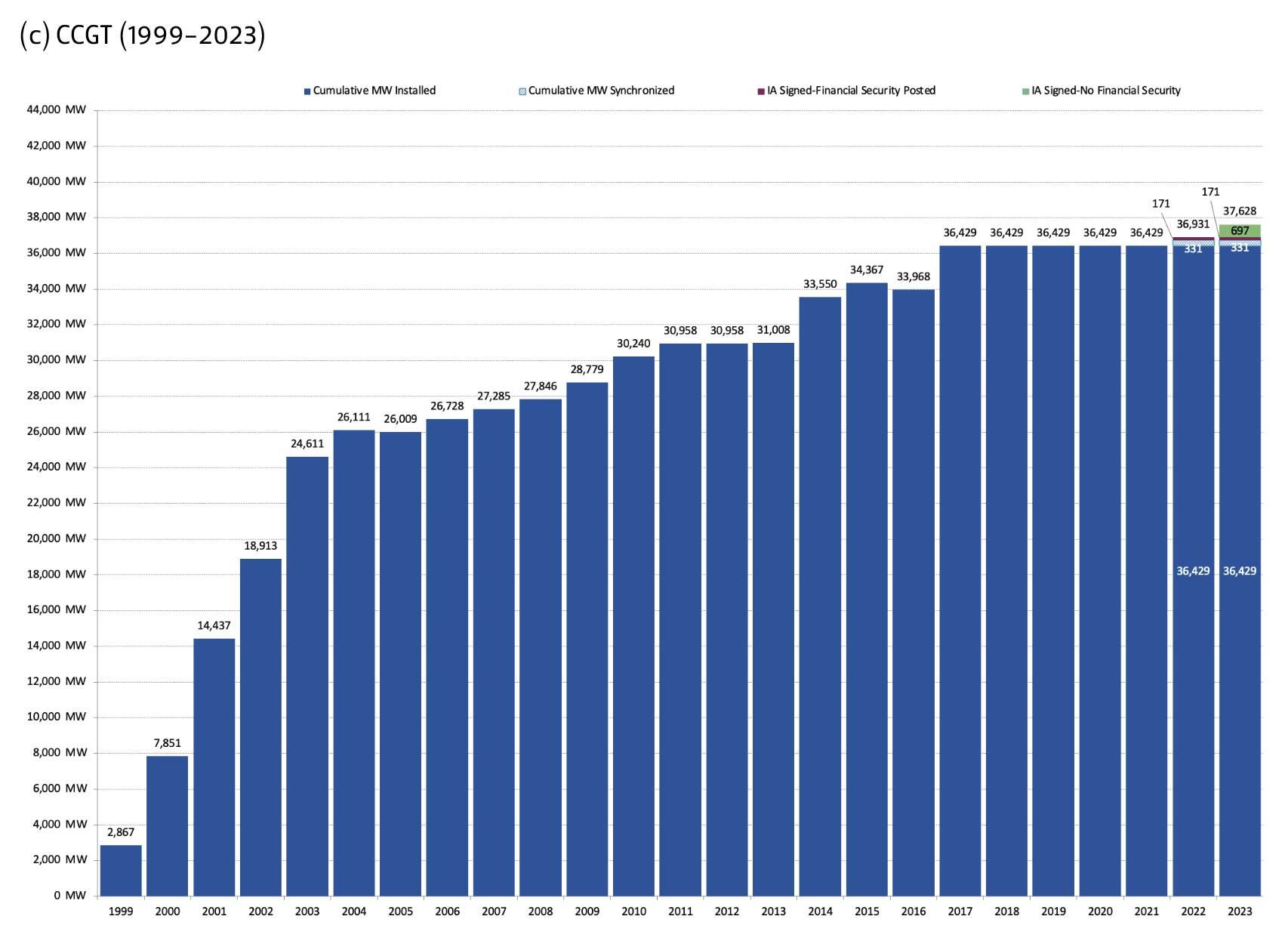
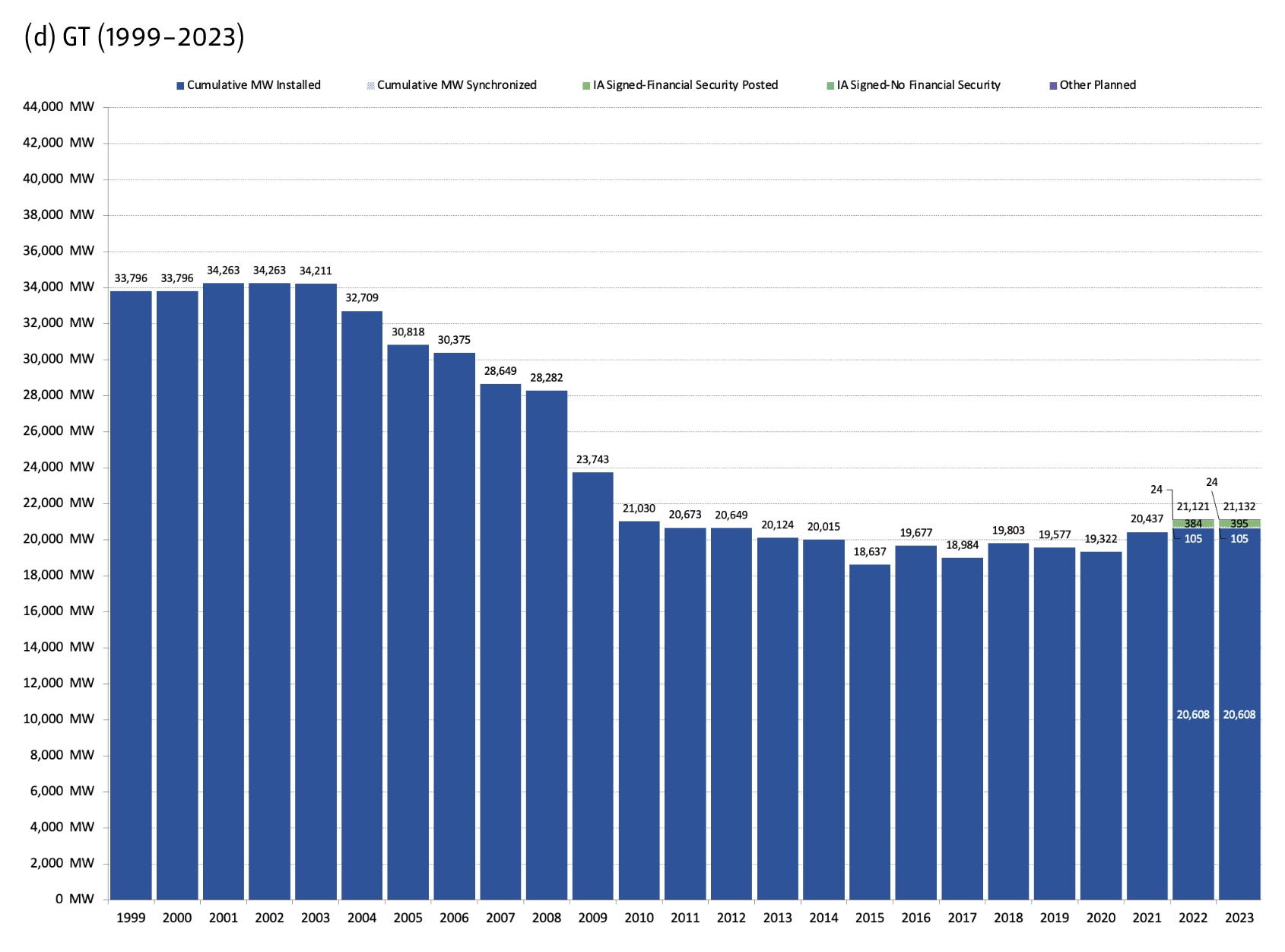
Data on growth in demand (see Figure 1), growth in generation capacity (see Figure 2) and increased volatility of supply due to the rise in intermittent resources (see Figure 3) reflect a need for different types of capacity to meet demand reliably. At the same time, the regions of demand growth in Texas, which are concentrated in and around the Texas triangle, are not co-located with the most rapidly expanding generation resources — wind and solar in West Texas. This highlights the importance of maintaining adequate transmission for ensuring reliability.
As evidenced in Figure 2, wind and solar capacity have increased dramatically in Texas since 2000, more than any other state, in fact, on a combined capacity basis. At the same time, natural gas combined-cycle capacity has stagnated over the last five years after seeing substantial growth the previous 15 years. Other gas-fired generation capacity has declined since 2000. It was also noted that coal generation capacity has declined (not pictured) across Texas since 2000. This means the majority of capacity expansion in Texas over the last 15 years has been in intermittent renewable generation sources.
Figure 3 — Wind Generation in ERCOT, 15-min (Jan. 1, 2009 – Oct. 1, 2021)
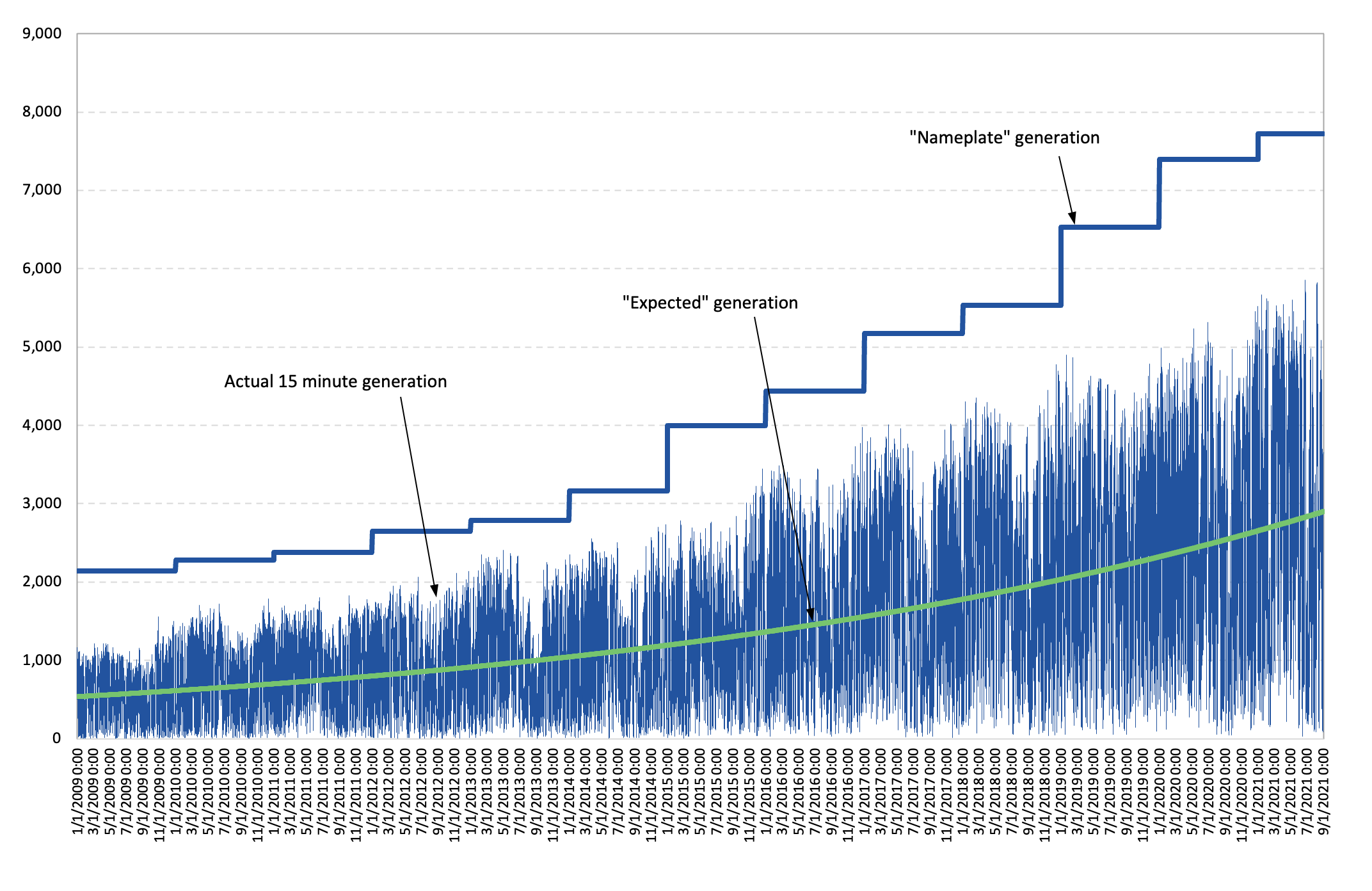
The expansion of intermittent sources of generation is a critical point in addressing the reliability of electric power markets. Texas has the largest operating and planned wind capacity in the US. As highlighted in Figure 3, average wind generation increases as wind capacity grows. Figure 3 is constructed using 15-minute generation data and data for installed nameplate capacity available from ERCOT. The “expected” generation is constructed as the best fit over time of the actual 15-minute generation data, so it represents how average generation from wind has evolved over time. Capacity data is reported less frequently than generation data, which is why it appears as a step function. But, on average, it is evident from Figure 3 that wind generation is growing with capacity, which carries with it the desired environmental attributes for the grid on average. But averages are not relevant for addressing reliability; we must recognize variability to address reliability.
The delivery of sufficient electricity supply to meet demands that change on very short time scales — often within and across days — as well as longer time scales across seasons and years, is challenging. This is not a new problem. Historically, utilities and market participants managed the variability in demand by deploying a portfolio of generation resources to accomplish the task of providing reliable supply at the least possible cost. As the generation portfolio continues to evolve — favoring environmental attributes of renewable resources such as wind, and thereby introducing greater variability in supply — it is important to consistently revisit what resources are needed to maintain both affordability and reliability.
If we mean-normalize the generation data in Figure 3, we can examine the variation in wind generation in a more conventional way. Figure 4 indicates the results of mean-normalizing the generation data and transforms it into a histogram to gain insights into the distribution of generation outcomes. While wind generation capacity and average wind generation has grown, when normalized on the average generation for each month, there is no trend.[5] In Figure 4, the maximum observation relative to the average is 3.625, and the minimum is 0.000, indicating a significant spread from maximum to minimum. Moreover, there is a relatively flat distribution within one standard deviation (yellow lines) of the mean (red line), indicating a very similar likelihood of each generation outcome in that range.
Figure 4 — Wind Generation in ERCOT, 15-min, Mean-normalized (Jan. 1, 2009 – Oct. 1, 2021)
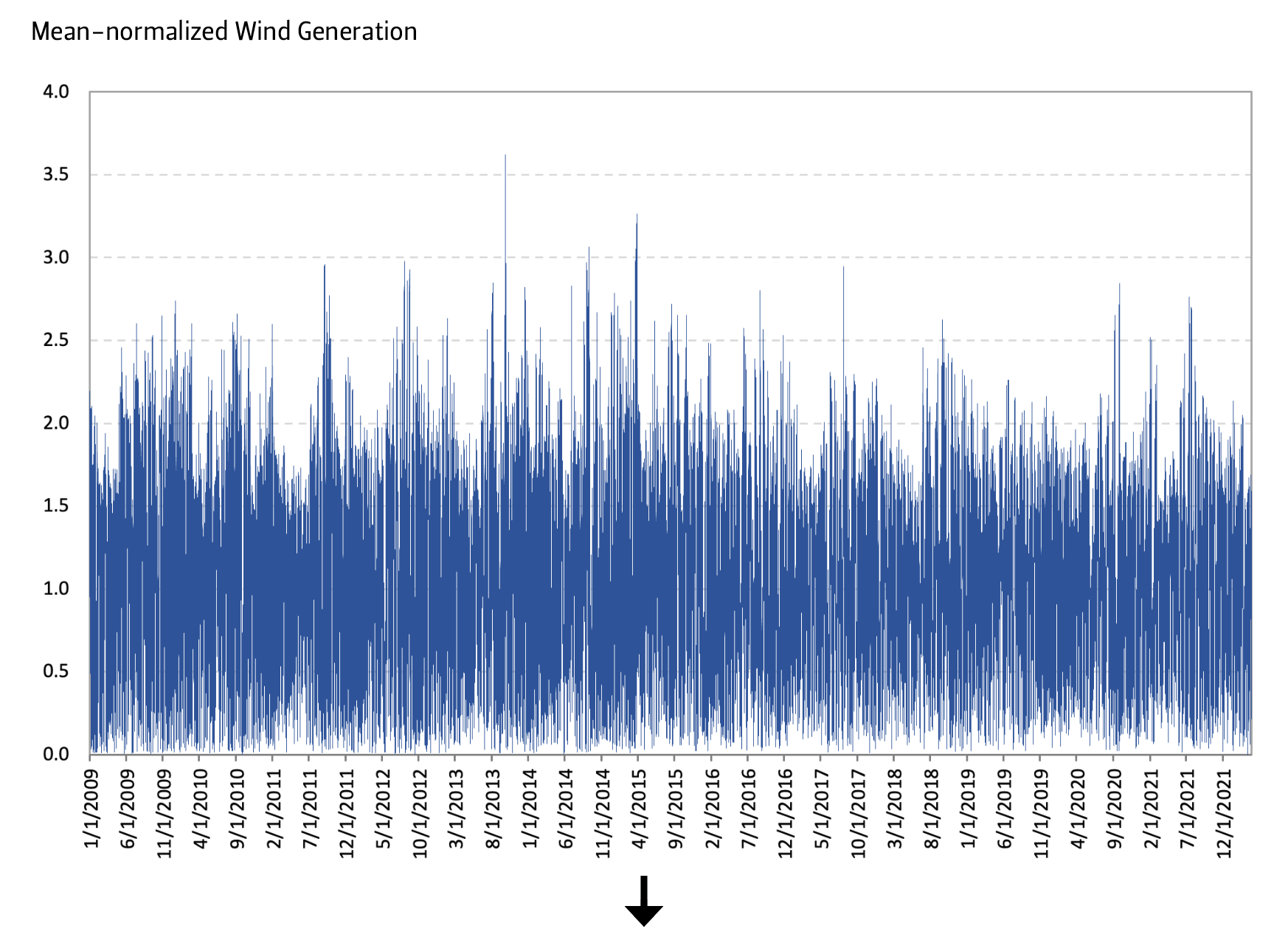
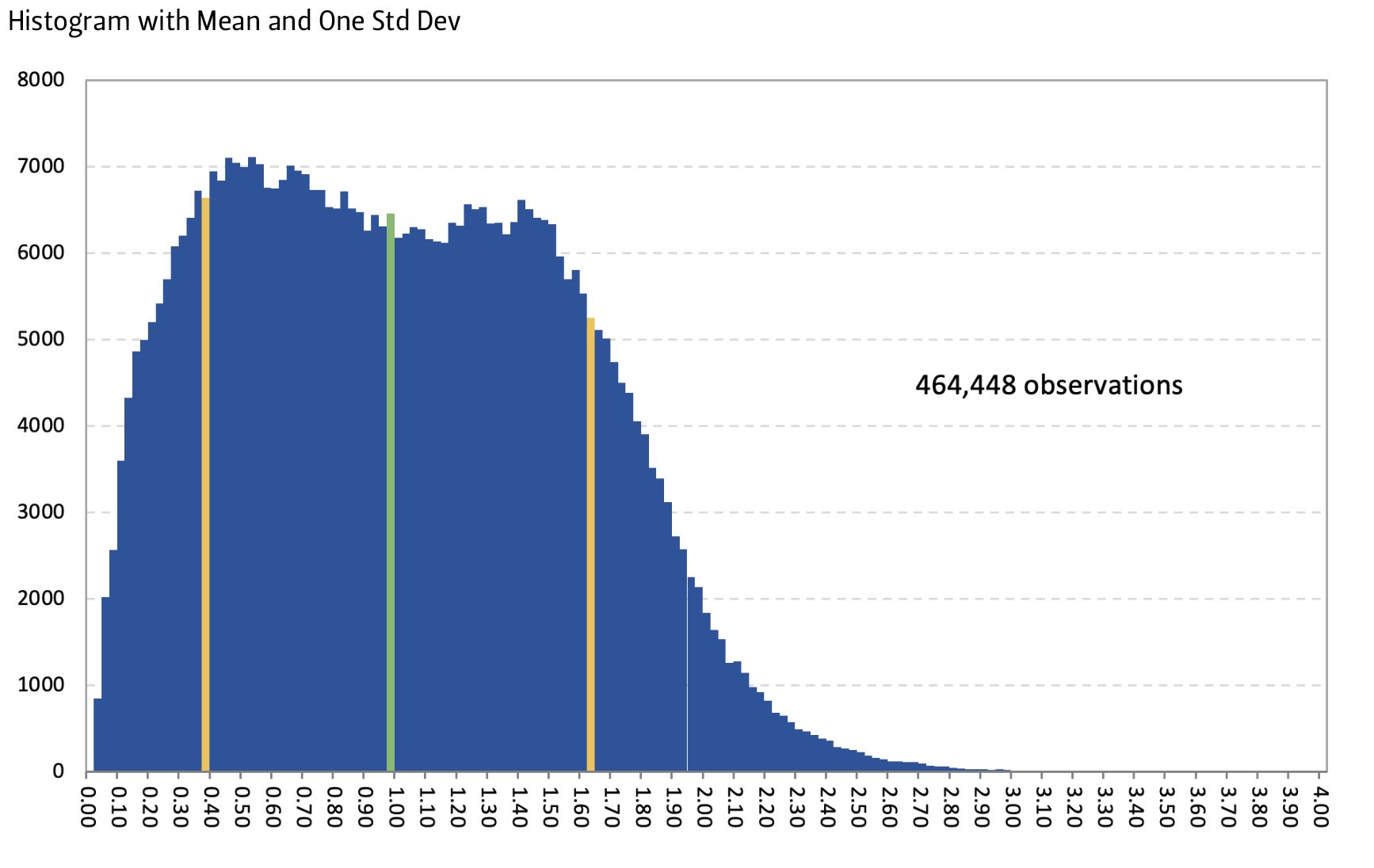
It should be noted that as the average generation from wind increases, which occurs as capacity is added, the actual difference between the minimum and maximum values also increases (as can be seen in Figure 3). In order to accommodate this growing variation in supply, especially when wind generation falls below average, sufficient dispatchable backup generation is required. Hence, backup generation resources serve as insurance for intermittent resources, and reliability dictates sufficient insurance is required. Notably, this increases the capital intensity for each MW of wind capacity added to the generation portfolio, effectively amounting to an insurance premium that must be incurred to assure resource adequacy. This means more backup capacity is, and will be, required — regardless of the type (natural gas, batteries, hydro, etc.) — as intermittent resources are added. It was noted during the discussions that “backup” resources can include demand-side management strategies, especially for large interruptible consumers, so additional generation resources are not the only means of providing reliability insurance.
The Role of Risk Premiums and Insurance |
|
A risk premium is commonly defined as the difference between the returns on assets with quantifiable risk and the returns on assets that are risk free. For investors, an asset’s risk premium is a form of compensation that reflects an additional payment for investor “tolerance” of the risk in a given investment over that of a risk-free investment. Risk premiums are often discussed as potential tools for correcting market distortions and providing price signals to market participants about a particular course of action — either through investment or operations — in a variety of situations. This allows risk-averse actors to appropriately internalize the costs of their actions. As indicated in the figure below, as the risk associated with a particular course of action rises, the risk premium rises. This is at the core of how insurers price insurance policies on different activities, with riskier activities requiring higher premiums. In order to adequately warrant against undesirable outcomes, risk must be priced into the activity. In the Texas electricity market, risk premiums would capture the value of reliability to market participants. Prices needed to ensure resource adequacy and other services for reliability would incorporate these premiums. For instance, wind variability introduces a reliability risk. An appropriate risk premium to account for this and pay for backup capability (which could be additional natural gas capacity, battery installations, demand-side management programs, etc.) would compensate investment by providing a more robust marketplace for capacity additions. 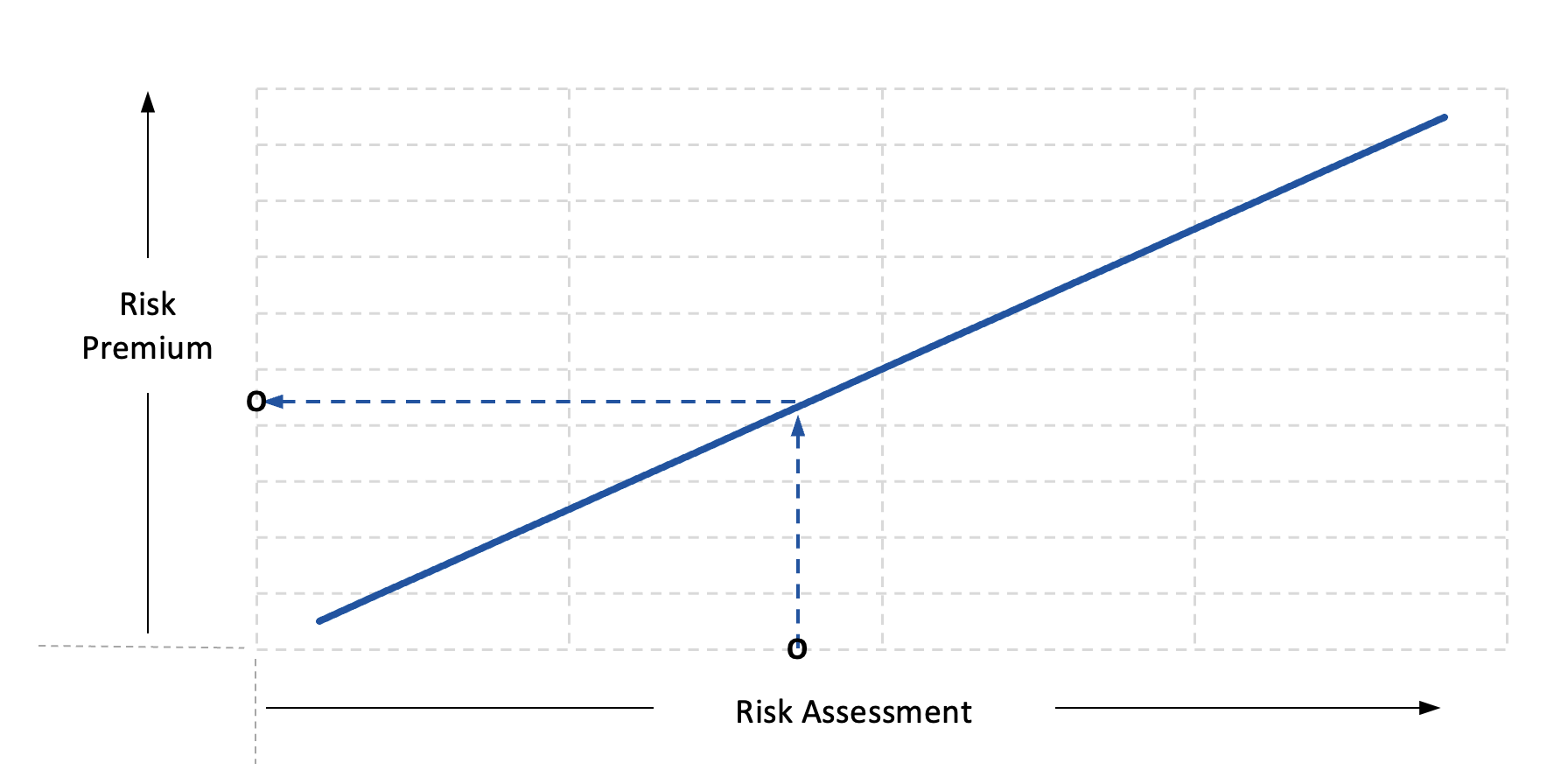 |
Texas ranks third in the nation in operating solar capacity, but first in planned capacity additions. The expansion of solar has the potential to offset some reductions in wind generation, especially when they occur during the daytime, but solar can also vary during the day, so the need for backup resources is not eliminated. The risk profile of available MWh will continue to evolve and bears careful attention going forward.
Regarding battery storage, Texas ranks second in the nation for both operating and planned capacity. However, state of the art grid-based stationary battery units constitute a limited duration option for load balancing. Typical battery units are capable of serving single evening peak loads but not extended periods of time — especially not multi-day weather events like Winter Storm Uri. The addition of battery capacity is an added capital expense, so the costs must be balanced with the costs of other potential options to maintain reliability over different periods of time.
Overall, uncertainty about grid reliability remains considerable, driven by varying demand projections, new capacity additions and potential extreme weather events. Regarding current emergency backup options, while ERCOT experienced significant growth in gas combined-cycle (CCGT) capacity over the period 2003-2016, CCGT additions have since flattened, and gas combustion turbine capacity has decreased. Thus, the flexibility that gas has historically provided may not be sufficient going forward, which means new capacity investments are needed for future reliability.
Discussion
What Constitutes Reliability and Who Is Responsible for It?
The roundtable discussions that emerged from the presentations and opening remarks were insightful, and they reached beyond ERCOT. The question, “How should we define reliability?” was openly discussed. Roundtable participants distinguished between reliability that is system wide and reliability that is at the level of a load serving entity (LSE), and there was debate whether the two should be combined or remain separated. Participants noted that reliable electricity services hinge upon the entire system being able to ensure reliable operation ahead of individual entities delivering reliable service. System-wide reliability thus became a focal point of the discussions, and the reliability of LSEs was recognized as symbiotic with the entire system.
The ERCOT retail competitive market serves as an intermediary between wholesale buyers and retail end-use customers. This means wholesale market participants must deal with real-time price fluctuations driven by the availability of supply relative to demand, while individual retail customers see prices adjust on a less frequent basis as wholesale market participants absorb volatility and pass along its costs. To increase reliability, one proposal aims to assign quantity and price risk to generators, requiring a match of long and short positions across generators. In this scheme, generators would be required to meet full-load requirement contracts in the short-term market as the sole market participants, effectively balancing the short-term market on a contractual basis with the intent of incentivizing investments in dispatchable capacity. It was noted that such an approach proved successful with market restructuring in countries with significant hydro resources, like Chile and Peru.
Participants also expounded on what would constitute a reliable system at the least cost. It was argued that this could be achieved through monetizing flexible demand in addition to a system-wide reliability product for retail energy providers (REPs), most likely with significant demand-response participation. This raised the question of the “acceptable degree” of reliability, especially when risk tolerance varies between commercial market participants and the general public. It was argued that achieving a degree of reliability where there are infrequent, occasional rolling blackouts — but not extended blackouts like what occurred during Winter Storm Uri — would cost less than building a system that could credibly insure against any occasional or extended blackouts. Nevertheless, the public’s willingness to accept such a path was recognized as critical — and uncertain.
It was emphasized more than once that a reliable power system requires both sufficient and operable capacity. As such, redundancy and backup capacity have long been deemed critical for system reliability. In addition, the ability to develop sufficient capacity that remains operable under periods of high market stress is crucial. This means investment must be sufficient to keep pace with growth in demand (i.e., capacity), and there must be enough care taken to ensure all capacity remains operable (i.e., maintenance). In this context, the recent rolling blackouts in California and the extended blackouts during Winter Storm Uri were each noted as illustrating the importance of having effective incentives and/or regulatory oversight for generators to perform when needed.
The discussions around the need for incentives and/or oversight raised the “externality of reliability” as a persistent challenge. In the existing Texas market design, REPs tend to under-procure, because the full cost of reliability is not internalized. Several participants proposed either explicitly internalizing the full costs of reliable service, which would lead to rate adjustments, or allowing price signals to function unimpeded. It was recognized that dynamic pricing is key to reconciling variable supply and demand, as well as system flexibility. However, solutions that explicitly raise prices were deemed to be politically unfavorable.
For wind and solar, participants noted that the central challenge lies in the juxtaposition of intermittency and reliability. One argument presented was that wind developers do not build for reliability; instead, they build based on economics that are favored by subsidies, low operating costs and state-funded transmission capacity via the competitive renewable energy zone transmission system. In addition, it was noted when wind operators receive fixed payments under standard power purchase agreement terms, there is no incentive for them to hedge for non-performance to warrant stable power flows from backup or alternative energy sources.
Market Designs for Resource Adequacy
The discussion about the manner in which wind generation has been added to the grid in ERCOT was central to the consideration of market designs for resource adequacy. Participants debated many market design ideas for ensuring sufficient generation capacity, such as (i) energy-forward obligations, (ii) centralized residual auctions for market clearing, (iii) unbundling of energy and capacity products, and (iv) centralized/decentralized/hybrid mechanisms. It was generally agreed that a comprehensive market design must consider “all of the above” scenarios and solutions — including demand response programs, growth in distributed generation and an expanded electric vehicle system — to be resilient to the extremes. Participants also underlined the importance of price discovery/market transparency and the potential role of sufficient penalties for non-performance when considering market designs aimed at ensuring resource adequacy.
Would A Capacity Market Enhance Reliability in ERCOT?
A large part of the discussion focused on two mechanisms: (1) an operating reserve demand curve (ORDC) energy-forward market and (2) a capacity market. Regarding the ORDC, which establishes how electricity is priced as reserve generation becomes scarce, the idea is to provide earlier price signals to bring additional generation online and/or to incentivize large consumers to adjust their demand.[6] Central to this determination is the value of lost load and the loss of load probability. In any case, the discussions on the ORDC focused on the price cap, co-optimizing with a capacity market, and the risks of “double paying” the ORDC and capacity market if both are active. It was also pointed out by one participant, who has experience simulating different market regimes, that the price paid in a capacity market was generally higher than in an ORDC energy-forward market. This comment was made in the context of the relative effectiveness of the ORDC versus a capacity market, and what the price cap on the ORDC would need to be to accomplish the goal of sufficient increased capacity investment.
The discussion on capacity markets proved contentious. For instance, despite calls by some advocates that a capacity market would have helped ensure sufficient capacity to deal with Winter Storm Uri, it was noted that the bigger issue during that event was operable capacity, not nameplate capacity. Hence, the argument that a capacity market would provide adequate insurance for reliability and resource adequacy in ERCOT was not accepted by all participants. Indeed, several participants questioned why there is a continued focus on capacity if an energy-forward system could be sufficient on its own. Again, participants stressed the importance of effective price discovery and penalties for non-performance or obligations to procure other supplies if generators failed to produce.
During the discussion on capacity markets, participants considered centralized procurement auctions versus decentralized bilateral contracts via LSE obligation. They also underscored the need to differentiate market structure for LSEs that only serve interruptible load versus LSEs that only serve residential load with fully hedged reliability contracts. It was argued that decentralized bilateral contracts could reduce competition and marginalize smaller market participants, thus requiring a market-efficiency justification. The establishment of adequate performance requirements was deemed critical, and the market structures in PJM[7] and ISO-NE (Independent System Operator-New England) were noted for their enforcement of heavy penalties on capacity suppliers for performance failures. Despite the extended discussion on capacity markets, participants agreed that Texas maintains a history of aversion to capacity markets and that a decentralized system would be preferred over ERCOT’s central control.
Co-optimization of the two mechanisms — an ORDC energy-forward market and a capacity market — was raised as a possibility. Participants also considered a potential reform of the current ORDC, cost allocation issues for different proposals and the risk of market power arising under new mechanisms. Regarding market power, LSEs cannot own more than 20% of the generation capacity in ERCOT, but there are no market share limits on REPs. Thus, market monitoring and mitigation tools will be necessary to require REPs with generation capacity to disclose transparent and available resources for purchase in order to prevent price manipulation.
Participants also discussed the risks of double payment when incorporating the two mechanisms. Financial instruments such as call options were proposed as a potential solution. However, given that fuel price is a variable cost that could undermine the option value, there is a potential disincentive for market participants to carry out contractual obligations. For example, it was noted that generators in the Australian market did not produce energy under similar obligations because the option strike price was too low to operate and recover cost. Instead, generators would receive higher payments if the Australian Energy Market Operator (AEMO) asked them to operate, which led to the AEMO having to suspend the market in the resulting disarray.
New Reliability Mechanisms Come with New Risks and Uncertainties
Turning to load-side reliability mechanisms proposed by the PUCT, participants agreed that the LSEO program is a version of a capacity market. ERCOT would define demand and allocate across individual LSEs. Each LSE then chooses its approach to meeting allocated demand on a forward basis. Since REPs are responsible for delivery, it was noted that adequate regulatory oversight is required to prevent REPs from taking actions that could result in under-procurement. In the end, ERCOT must determine the value and quantity of each generation source required for LSEs to meet their allocated obligations so that new generation can ultimately be incentivized. ERCOT also needs to consider all factors in assessing capacity credits in effective load carrying capability accreditation.
Considering the DECs program, participants pointed out that inherently subsidizing new capacity with credit procurement requirements could “bump out” older, unsubsidized generators in a competitive market. There were concerns that this would not necessarily serve to increase resources available to the grid and could compromise reliability. In addition, it was noted that uncertainty remains regarding which technologies would be subsidized and how large the program would be.
Participants saw the backstop reliability service as akin to an insurance policy with distinct risk premiums, where the program pays accredited generators to withhold energy only to be dispatched during emergency conditions.[8] In effect, the payment to withhold is the insurance premium, and the resulting higher prices that result provide incentive to make new investments. One utility provider noted that 10% of capacity must be withheld as backup capacity for use during emergency situations to effectively stimulate energy prices and incentivize new investment as intended. However, it was also recognized that greater variability in supply would likely require even higher energy rents (risk premiums) to justify the needed long-term investment. This is a recognition that greater supply risk begets a higher premium to insure for reliability and resource adequacy.
Participants also pointed to potential unintended negative consequences if LSEs’ obligations are contracted into the backstop reliability service. Doing so would allow LSEs to generate and withhold energy simultaneously. In the case of Colombia, electricity providers made payments to reserve thermal capacity in a similar scheme. During a recent El Niño cycle, those market participants handed the reserved resources to the government to operate the capacity, resulting in market failure.[9]
The future of distributed energy resources (DER) was also considered in the roundtable discussion, with participants recognizing that an expansion of electrification will benefit DERs. Proposed ideas for DER expansion included procuring investments to facilitate bidirectional flows and using EVs as demand response. It was argued that the latter should be further investigated by regulated transmission and distribution (T&D) entities to assess the information collected at EV charger sites to date. This is an important step for understanding the infrastructure requirements for scaling up EVs and EV charging capabilities. Regarding scaling up EVs, participants noted challenges such as the high cost of new infrastructure requirements. For instance, bi-directional adapters cost $7,000-$8,000 per household in addition to the EV cost. It was stated that new capital investment, along with additional PUCT approval for cost recovery to T&D companies, would be required if EV market penetration reaches 15% (for smaller batteries) to 25% (for large batteries such as trucks and sports utility vehicles).
Several participants stated that DERs chiefly benefit wealthier retail customers, noting the example of rooftop solar in California. It was also noted that T&D charges and balancing costs that arise with the growth in household solar capacity are shared among all residential consumers connected to the grid, not just the households that are adding the capacity, which amounts to an indirect subsidy for DER. Given that lower-income households cannot generally afford to install rooftop solar, wealthier households are the chief beneficiaries of the direct and indirect subsidies. In addition, wealthier households are better able to afford home-based backyard gas-fired generators for reliability. This means reliability services, to the extent they are provided by DERs, are largely benefitting wealthier households. In ERCOT, there has been significant recent growth in rooftop solar capacity.
Participants agreed that tapping into demand response (DR) is critical for resource adequacy to keep up with population, load growth and expansion of wind and solar generation. One element of DR is “time of use” pricing to incentivize load shifting to less stressed, cheaper periods. Participants proposed several options as potential DR products including efficiency improvements and flexible demand, such as forced selection of energy conservation on peak days between office and home. Based on complaints during Winter Storm Uri of energy consumption by unoccupied commercial buildings that could not be switched off by ERCOT, another proposed option was load control in older buildings.
In a pilot case, smart thermostats that are adjusted by the LSE during times of stress revealed an ability to achieve a 20% demand reduction when called upon during summer peaks. However, the lack of DR schemes in the residential market presents an economic barrier to higher smart thermostat penetration. Currently, most DR participation in ERCOT results from commercial and industrial customers utilizing the 4CP (four coincident peak demand charge management) incentives. This is not available for residential customers. Participants proposed that LSEs could pilot DR programs in which residential users are compensated by (1) receiving credits for a lower obligation, (2) direct payment or (3) resale of the avoided energy use to other customers.
Roundtable participants also stressed the importance and potential impact of marginal price signals — dynamic pricing — to activate flexible demand response. But, when the question of whether utilities should expose end consumers to real-time pricing was posed, there were reservations among participants. In particular, there were concerns that it could result in a pricing debacle like the infamous Griddy fiasco, in which customers faced exorbitant energy bills following Winter Storm Uri.[10]
Key Takeaways
The roundtable discussions on resource adequacy in ERCOT did not yield any specific policy guidance, but they did provide key insights that policymakers and regulators should consider. For one, it is important that redundancy, or backup, on the electric power system be sufficient and operable to accommodate continued growth in intermittent generation resources. Moreover, rather than focus on a single type of generation resource, a portfolio approach that covers multiple margins of response — e.g., dispatchable generation capacity, demand response, conservation and efficiency in end use, distributed generation, etc. — would afford the least-cost outcome for reliability. Currently, natural gas is the most ideal dispatchable option for redundancy and will likely remain so for the foreseeable future. However, longer-term innovations and investment could alter this. As such, policies and market designs that seek to enhance and ensure reliability should remain agnostic to technology options.
Participants also recognized that environmental externalities associated with different generation options must be considered, and they also stressed that reliability presents an externality that must be considered simultaneously. The value of reliability is currently not adequately priced into the electric power market, while environmental preference is (through subsidies). This yields incentives to address one but not the other, which has driven the market into a state of uncertainty over reliability. Although market design reform places a significant focus on LSEs to improve reliability, system reliability must be in place to provide a functional market. Hence, reliability must be priced as a feature of generation resources.
Roundtable participants discussed a number of proposals under consideration by the PUCT. How the rules of the market ultimately shake out is yet to be known. But, regardless of which combination of market reforms are adopted, participants acknowledged that there will always be risks. Namely, the system cannot reach 100% reliability, but it should strive to get as close as possible. Doing so mandates an appropriate assessment and pricing of risks to the system. Therefore, appropriate market design and sufficient regulatory oversight is critical, which ranges into topics from market structures that ensure sufficient backup capacity to adequate penalties for underperformance by generators under specific obligations.
The discussions remained fairly high-level during the workshop, as there was little focus on characterizing different generation resources by fuel type, and there was no discussion regarding what kind of capacity should be stimulated. This reinforces the point that market designs should be technology agnostic and remain focused on pricing reliability as an attribute or service. Participants also did not discuss the technical details regarding how to ensure operational redundancy or how to designate performance requirements and non-performance penalties for generators; this is a point left for market regulators and policymakers. But participants did emphasize these things should be adequately addressed to promote greater system reliability.
Endnotes
[1] Peter Hartley, Kenneth B. Medlock III, and Shih Yu (Elsie) Hung, “ERCOT Froze in February 2021. What Happened? Why Did It Happen? Can It Happen Again?” Baker Institute Working Paper, February 2, 2022, https://www.bakerinstitute.org/research/ercot-froze-february-2021-what-happened-why-did-it-happen-can-it-happen-again.
[2] The appendix provides two slides that were presented to frame the PUCT actions.
[3] For a description of Phase I of the reforms, see Mark Watson, “Texas regulators order power market reform Phase I, analysis of bigger changes,” S&P Global Commodity Insights, December 16, 2021, https://www.spglobal.com/commodityinsights/en/market-insights/latest-news/natural-gas/121621-texas-regulators-order-power-market-reform-phase-i-analysis-of-bigger-changes.
[4] Interestingly, regression analysis of the drivers of electric power sales reveal that state GDP and price have greater statistical significance in explaining electricity sales in Texas. In fact, regression analysis reveals

with an R2 of 0.9862 controlling for autocorrelation. We report this merely for completeness and because it speaks to the importance of economic growth and the role of price in electric power sales over the last two-plus decades.
[5] The normalization is done by dividing actual wind generation for each 15 minutes by the average wind generation for that month. An alternative approach would be to take the difference of actual generation from the monthly average, which would center the distribution on zero.
[6] See “PUC Approves Major Improvements to Electric Grid Reliability,” Public Utility Commission of Texas, News Release, December 16, 2021, https://www.puc.texas.gov/agency/resources/pubs/news/2021/puctx-rel-market_redesign_12162021.pdf
[7] “PJM is a regional transmission organization (RTO) that coordinates the movement of wholesale electricity in all or parts of 13 states and the District of Columbia.” See https://pjm.com/.
[8] ERCOT’s Energy Emergency Alert (EEA) communications. EEA3 is the most extreme with rotating outages in progress during those events.
[9] “The [hedging] mechanism comprises Firm Energy Obligations (OEFs) that commit generators to supply given amounts of energy (called firm energy) at a predetermined situational Scarcity Price (SP). In return, generators receive a fixed annual option fee — the Reliability Charge (RC) — for each kilowatt hour contracted, paid by consumers in their electricity tariff and determined via auction.” A confluence of events — including fire damage at Colombia’s largest hydroelectric plant during the El Niño drought and the 2015 collapse in diesel prices, to which the SP is linked (with permanent lower adjustment by the regulator) — resulted in inadequate fuels for thermal generation and a cost to produce thermal power that was nearly seven times higher than the SP. See “El Niño|Colombia|2015/16,” Case Study Series: Extreme Weather, World Energy Council, September 2019, https://www.worldenergy.org/assets/downloads/El_ni%C3%B1o_Colombia_-Extreme_weather_conditions_SEP2019.pdf.
[10] See Diana Zoga, “One Year After Power Crisis, What Happened to Those Big Electric Bills?” NBC 5 Dallas-Fort Worth, February 15, 2022, https://www.nbcdfw.com/news/nbc-5-responds/one-year-after-power-crisis-what-happened-to-those-big-electric-bills/2891039/.
Appendix
The following two figures — Figures A1 and A2 — are included for reference. They were presented by a workshop participant to help frame the discussions that followed.
Figure A1 — Presentation Slide on “Blueprint for Market Design Reforms (Jan. 2022)”
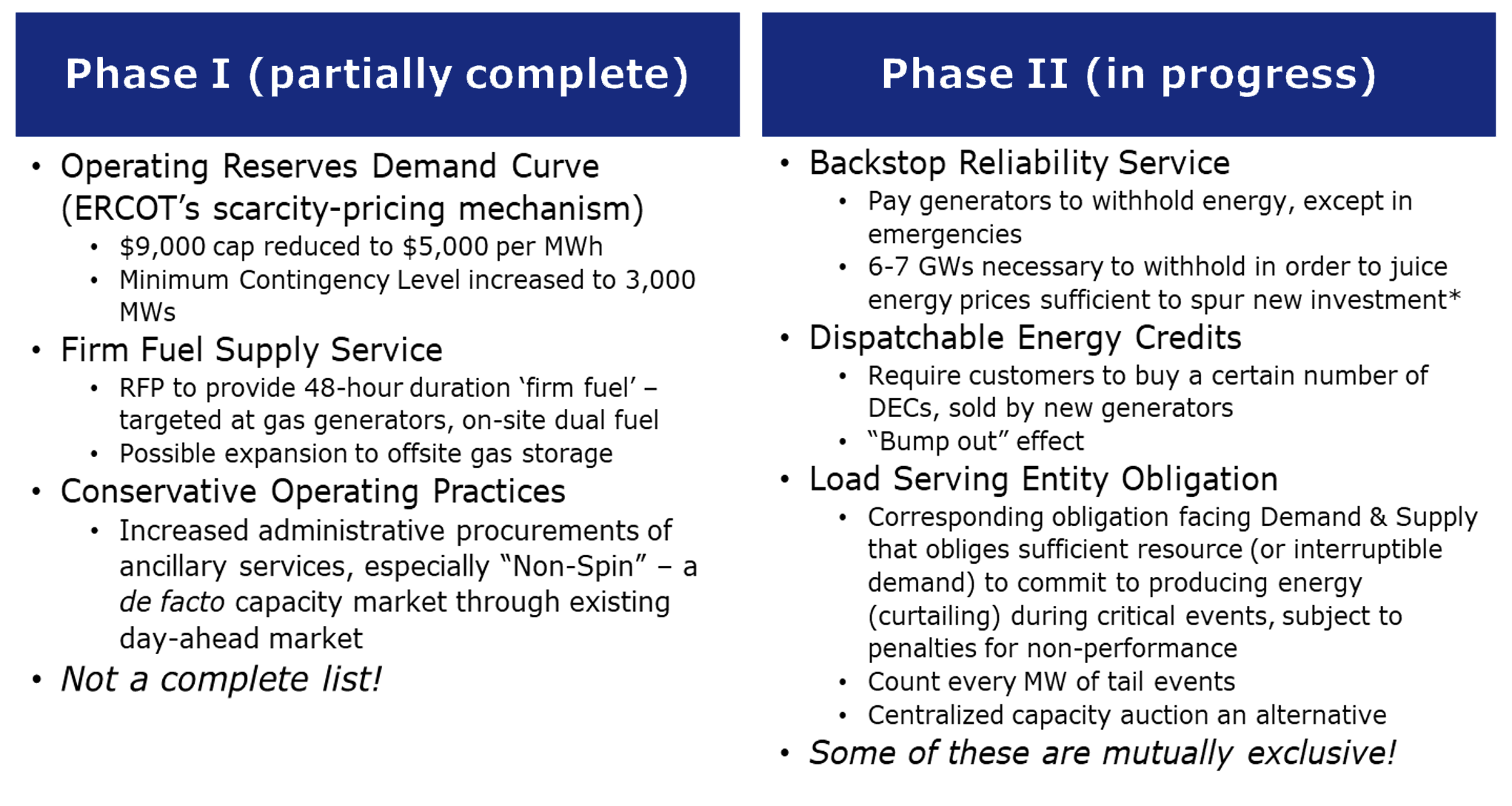
Figure A2 — Presentation Slide on “Phase II: Half-Measures or Something More?”
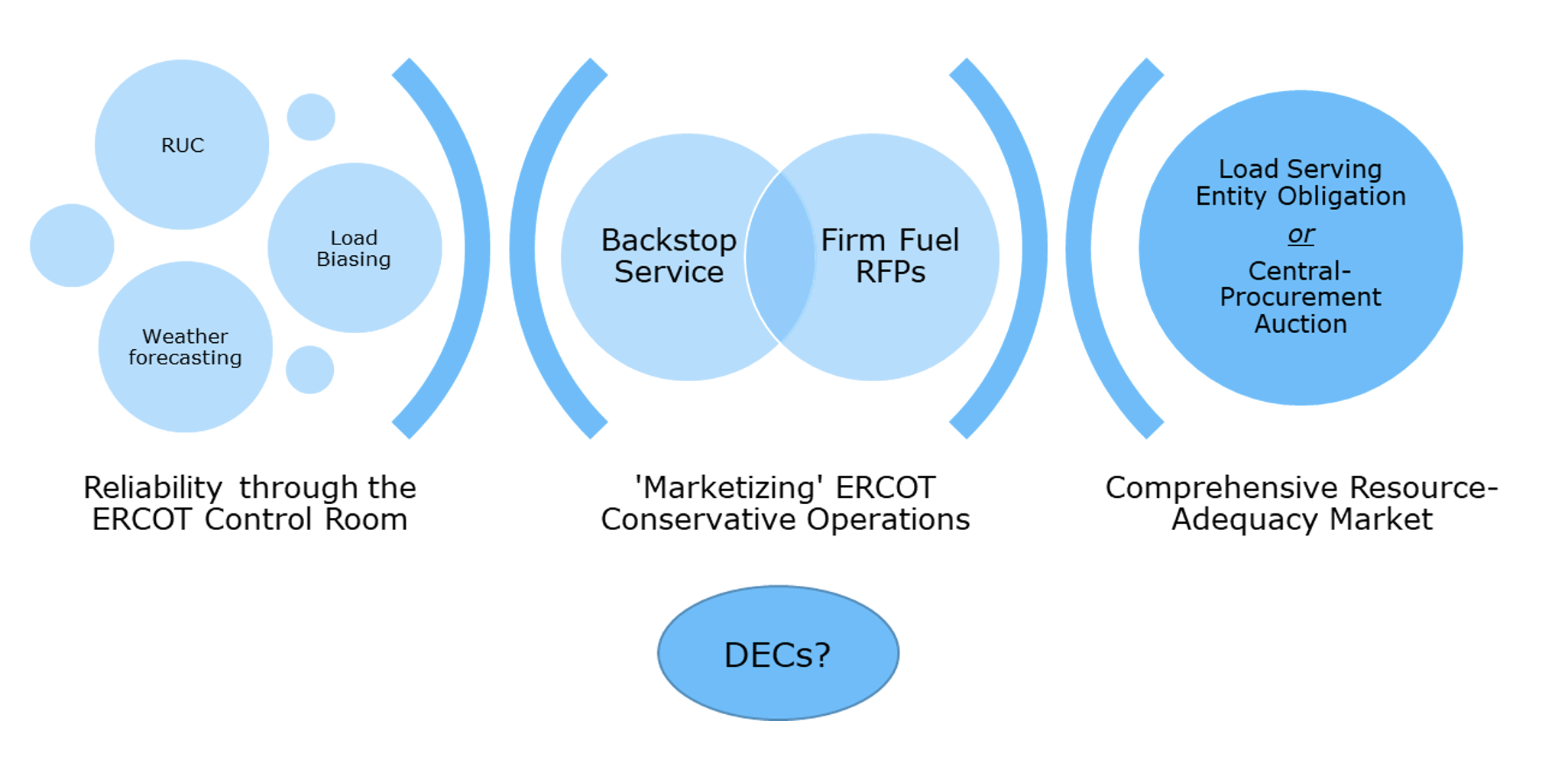
This material may be quoted or reproduced without prior permission, provided appropriate credit is given to the author and Rice University’s Baker Institute for Public Policy. The views expressed herein are those of the individual author(s), and do not necessarily represent the views of Rice University’s Baker Institute for Public Policy.


